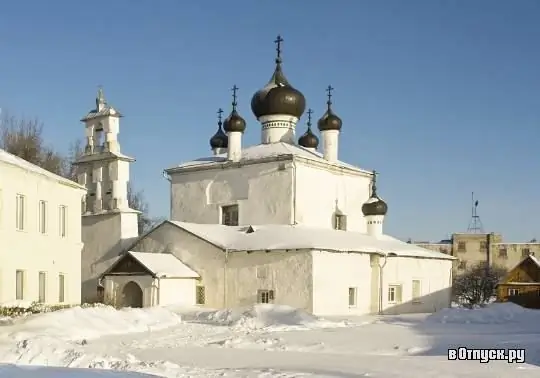
Description of the attraction
The Pskov Church of St. Nicholas the Wonderworker or St. Nicholas the Appeared from the Torg is the Orthodox Church of the Holy Trinity side-altar. It is located on the so-called New Torg, which appeared in Pskov in 1510, after annexation to Moscow. It is believed that the church of St. Nicholas the Wonderworker was founded in 1419, but there is no information about the fate of the building. According to the chronicle, the stone building of the church in its present form was erected in 1676 by the architect I. Baturlin.
The unpretentious architecture of the temple has been altered many times. The side-altar and the altar part were added later. In the main church, the facades have niches for icons. The dimensions of the church with the belfry are close to a square: the length is about 28 meters, the width is 26 meters. The height to the upper eaves is about 11 meters. On the west side, a belfry was erected on the facade of the church, which had 5 bells from 1693 and 1760. The bell of 1760 weighed over 400 kilograms.
The Church of St. Nicholas the Yavlenniy has 5 chapters, which is not typical for Pskov architecture, but rather for Moscow. It was studied by the Russian historian Ivan Zabelin, who came to the conclusion that this temple is the first example in church construction, when the chapters are placed not in the corners, but directed to the cardinal points. On the drum of the main chapter there were windows, most likely sealed up after the 1917 revolution, when the church was used as a warehouse. The drums of other chapters are deaf, elongated, widening towards the cornice. At the beginning, the chapters were covered with tiles, and now they are covered with metal. In addition, the church has a porch, a vestibule and a sacristy tent.
Scientist Yu. P. Spegalsky noted that the interior of the temple was distinguished by its richness: its entrance doors, made of iron and kept until 1941 in the Pskov Museum, were decorated with copper plates engraved with paintings depicting the history of three Christian martyrs: Azaria, Ananias and Misail.
Nikolskaya Church has a rich history. On May 11, 1676, a terrible fire broke out in the city, as a result of which many churches were damaged. In one of them, the Church of Paraskeva Pyatnitsa, the miraculous image of St. Nicholas was located. This church could not be saved, but the image of St. Nicholas the Wonderworker was saved and transferred to the new stone St. Nicholas Church, at which the chapel of Paraskeva Pyatnitsa was built, later renamed Troitsky. The church itself began to be called Troitsko-Nikolskaya.
In 1786-1842, the temple was assigned to the Intercession Church from Torg. In 1843, the church was renovated and consecrated by the Pskov Old Believers under the guidance of their mentor (later hieromonk) Mikhail. In 1890 the Nikolsky temple was reconstructed again. Since September 1896, with the blessing of Bishop Antonin of Pskov and Porkhov, priest V. Vostokov and psalmist A. Florensky on Sundays after akathist (chants in the church), moral, religious and anti-schismatic readings were held. In February 1914, the icon of St. Hermogenes, consecrated in the capital on his tomb, was transferred from the Trinity Cathedral to the Nikolskaya Church.
Since 1917, the church has been closed. It is possible that in 1920-1930s executions were carried out here, as evidence of this is the human remains found inside and outside the building with shot skulls. During the Second World War, the church also did not work. During the hostilities, there was a strong fire here. In 1995, the Church of St. Nicholas the Wonderworker was transferred to the Pskov Theological School. Since 2000, work has begun on the restoration of the church and the creation of a new iconostasis.






